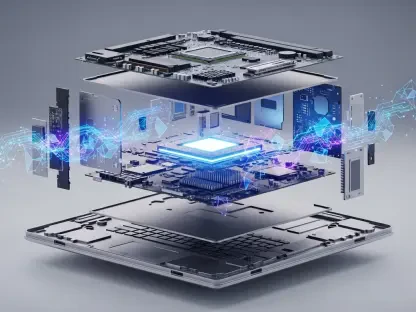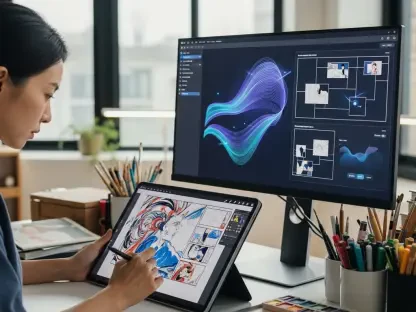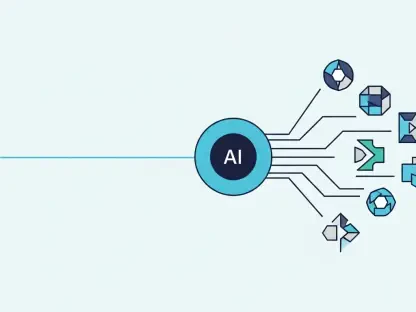Imagine a world where millions of people suffer silently from chronic liver diseases, with up to 90% of cases going undiagnosed due to limited access to non-invasive tools, affecting an estimated 100 million Americans with Metabolic Dysfunction-Associated Steatotic Liver Disease (MASLD) and 15-20 million with Metabolic Dysfunction-Associated Steatohepatitis (MASH). As therapeutic breakthroughs emerge, the urgency for accessible diagnostics has never been greater. This roundup gathers diverse opinions, tips, and reviews from industry experts, clinicians, and healthcare strategists to explore how Velacur ONE, Sonic Incytes’ FDA-cleared point-of-care ultrasound (POCUS) device, is poised to transform liver health assessment.
Unpacking Velacur ONE’s Technological Breakthroughs
AI-Driven Innovation at the Forefront
Insights from technology analysts highlight the cutting-edge features of Velacur ONE, particularly its AI-driven organ overlay and B-mode imaging capabilities. These tools enable precise liver localization, a significant leap forward in point-of-care diagnostics. The device also boasts Velacur Determined-Fat Fraction (VDFF), which offers a detailed assessment of liver fat content, correlating strongly with MRI-Proton Density Fat Fraction (MRI-PDFF) at a rate of 0.85.
Clinical technology reviewers note the impressive accuracy of Velacur ONE, with an Area Under the Curve (AUC) of 95% for detecting hepatic steatosis. This reliability positions it as a viable alternative to more cumbersome and costly traditional imaging methods. However, some caution that the integration of such advanced features may require substantial training for healthcare providers unfamiliar with AI-assisted tools.
Contrasting views emerge on the practicality of adoption. While many praise the portability and user-friendly interface, a segment of tech evaluators points out potential challenges in scaling this technology across diverse clinical settings, especially in resource-limited environments where budget constraints may limit initial uptake.
Addressing Diagnostic Gaps in Liver Disease
Healthcare professionals specializing in hepatology emphasize that Velacur ONE tackles a critical void in diagnosing MASLD and MASH, conditions often undetected until severe complications arise. With current statistics showing a vast majority of cases undiagnosed, the consensus is that non-invasive tools are essential for early intervention, and this device aligns seamlessly with clinical guidelines promoting imaging-based elastography.
Some practitioners, however, express reservations about over-reliance on point-of-care devices without robust long-term data. They suggest that while the technology shows promise in monitoring fibrosis and steatosis, ongoing studies are needed to validate its effectiveness in varied patient populations over extended periods.
A differing perspective from diagnostic innovators underscores the urgency of adopting such tools. They argue that the risk of delayed implementation far outweighs initial hesitations, as early detection facilitated by Velacur ONE could significantly reduce progression to cirrhosis or liver failure, ultimately improving patient outcomes.
Clinical and Economic Perspectives on Adoption
Shifting Toward Non-Invasive Liver Care Trends
Industry thought leaders observe a broader movement in healthcare toward non-invasive diagnostics, with Velacur ONE leading the charge through its integration of AI and portability. This shift is seen as vital for expanding access to liver health assessments beyond specialized centers, potentially benefiting rural or underserved communities.
Regional healthcare consultants add that the device’s adaptability to different clinical environments is a key strength, though challenges remain in addressing global variations in liver disease prevalence and resource availability. For instance, some regions may require tailored training programs to ensure effective use of the technology.
A contrasting viewpoint from clinical researchers challenges the traditional focus on liver stiffness as the sole indicator of disease progression. They commend Velacur ONE for prioritizing steatosis reduction as a critical marker of treatment response, aligning with emerging evidence that fat content changes are more indicative of therapeutic success in MASH patients.
Economic Benefits and Strategic Expansion
Healthcare economists highlight the financial advantages of Velacur ONE, noting its reimbursement potential is 3-4 times higher than non-imaging elastography tools. This economic incentive is viewed as a significant driver for adoption in clinical practices seeking sustainable diagnostic solutions.
Strategic analysts focusing on medical device markets point out Sonic Incytes’ ambitious expansion plans in the U.S. and beyond, starting from this year through to 2027. They suggest that the company’s focus on scalability could position the device as a cornerstone in global liver care, though some warn that market saturation and competition may pose hurdles.
A balanced perspective from hospital administrators emphasizes long-term cost savings. By reducing reliance on invasive procedures and mitigating late-stage interventions through early diagnosis, Velacur ONE could alleviate financial burdens on healthcare systems, though initial investment costs remain a topic of debate among budget planners.
Key Takeaways from Diverse Voices
Synthesizing the range of opinions, it’s clear that Velacur ONE stands out for its accuracy, alignment with therapeutic advancements, and potential to address the vast undiagnosed burden of liver diseases. Clinicians are encouraged to integrate this tool into routine screenings while advocating for comprehensive training to ensure proficiency in its use.
Healthcare providers and administrators also see value in leveraging this technology to enhance operational efficiency. Tips from practice managers include piloting the device in smaller cohorts to assess workflow integration before full-scale implementation, ensuring a smooth transition for staff and patients alike.
Finally, perspectives from patient advocacy groups underscore the importance of accessibility. They urge stakeholders to prioritize education campaigns that inform both providers and patients about the benefits of non-invasive diagnostics, fostering a collaborative approach to liver health management.
Reflecting on a Path Forward
Looking back on the discussions, the collective insights reveal a shared optimism about Velacur ONE’s role in reshaping liver disease diagnosis, tempered by practical considerations around training and adoption. The diverse opinions underscore a pivotal moment in healthcare where technology meets urgent clinical need.
Moving forward, stakeholders are advised to explore partnerships that could subsidize initial costs and expand access to this innovative tool. A focus on continuous research is also recommended to build a robust evidence base, ensuring that the device’s impact is sustained across varied populations.
Beyond immediate steps, the dialogue sparks ideas for broader innovation in non-invasive diagnostics. Consideration is given to how such advancements could inspire similar solutions for other chronic conditions, paving the way for a more proactive and accessible healthcare landscape.









